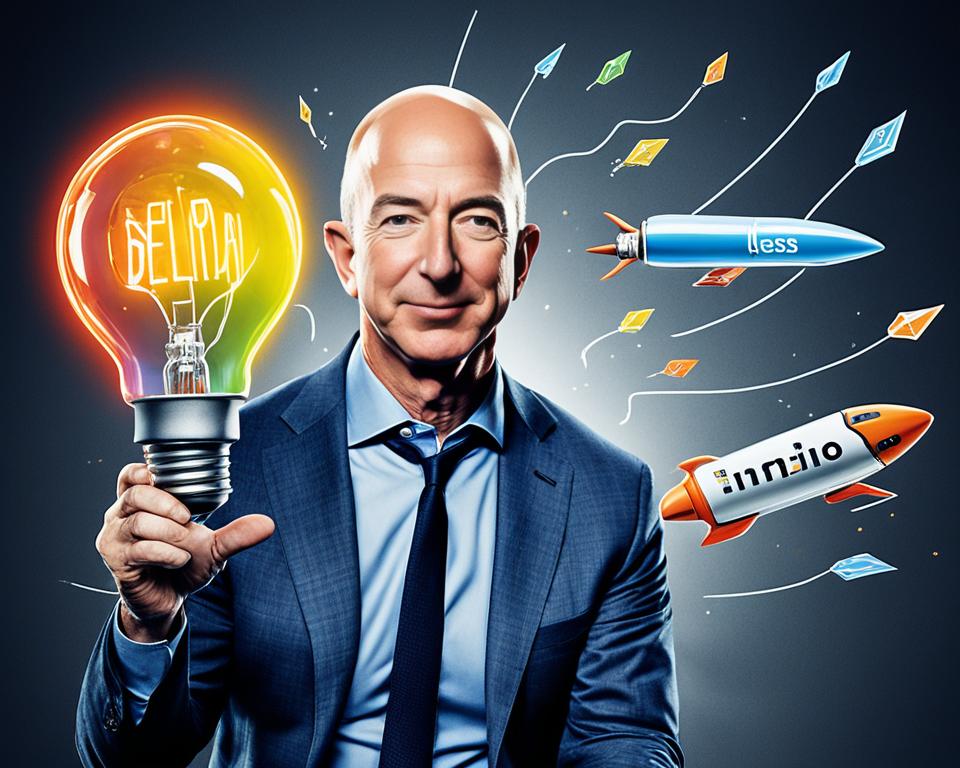Jeff Bezos, the visionary leader behind Amazon, has carved a distinctive path with his unique leadership style. His success can be attributed to a set of principles that have revolutionized the way organizations operate. From embracing failure to promoting continuous innovation, Bezos has left an indelible mark on the business world. In this article, we delve into Bezos’ leadership philosophy, exploring the Amazon leadership principles that have propelled the company to new heights.
Key Takeaways:
- Jeff Bezos’ leadership style is based on embracing failure, seeing it as a tool for learning and innovation.
- Effective communication is prioritized through the use of meeting memos, fostering productive and focused discussions.
- Continuous innovation is at the core of Bezos’ leadership approach, allowing Amazon to explore new opportunities.
- The “two pizza rule” emphasizes the value of smaller teams for better communication and collaboration.
- By adopting Bezos’ leadership practices, leaders can create an environment that drives innovation and success.
Table of Contents
Embracing Failure to Succeed More
According to Jeff Bezos, failure is not something to be feared but rather an essential part of the innovation process. He firmly believes that in order to truly invent and experiment, one must be willing to accept and learn from failures along the way. Bezos distinguishes between two types of failure – good and bad failure. While bad failure is a result of poor execution, good failure is integral to the process of product development and experimentation. It provides valuable insights, propelling organizations forward.
Bezos advocates for creating a culture where failure is not just accepted but embraced. This allows teams and individuals to take calculated risks and encourages collaboration in decision-making. He refers to this approach as the “waterline principle.” By setting a waterline, leaders can establish the boundary between acceptable and unacceptable failure, fostering an environment where innovation can thrive.
Embracing failure in this way allows organizations to push the boundaries and strive for groundbreaking ideas. It encourages individuals to think outside the box and take risks, knowing that failure is not the end, but rather a stepping stone on the path to success. By viewing failure as a tool for learning and growth, leaders can create a culture that propels innovation and fosters continuous improvement.
Throughout Bezos’ tenure at Amazon, his willingness to embrace failure has been a driving force behind the company’s success. By recognizing the value of failure and using it as a tool for innovation, Bezos has cultivated an environment that drives continuous improvement and pushes the boundaries of what is possible.
Innovation through Failure: An Amazon Case Study
Let’s take a look at how Amazon embraces failure and uses it as a catalyst for innovation. The table below highlights some key examples of Amazon products and initiatives that initially seemed like failures but ultimately transformed into successes:
| Product/Initiative | Initial Perception as a Failure | Transformation into Success |
|---|---|---|
| Amazon Fire Phone | Received poor reviews and failed to gain significant market share | Learnings from the Fire Phone paved the way for the development of Amazon Echo and Alexa, now highly successful products |
| Amazon Webstore | Shut down after only four years | Learnings from the Webstore led to the creation of Amazon Web Services (AWS), the leading cloud computing platform |
| Amazon Auctions | Failed to compete with existing online auction platforms like eBay | The lessons learned from Amazon Auctions contributed to the success of Amazon Marketplace, now a thriving third-party selling platform |
These examples demonstrate how failure can pave the way for future successes. By embracing failure and learning from it, Amazon has been able to iterate, innovate, and continuously improve their products and services.
By embracing failure as a tool, Jeff Bezos has not only created a culture of innovation at Amazon but also inspired countless entrepreneurs and leaders to view failure differently. It’s through failure that true learning happens, pushing individuals and organizations to grow and innovate. Failure should be seen as a stepping stone rather than an endpoint, and by embracing this mindset, we can unlock our true potential for success.
Using Meeting Memos to Save Time
In Jeff Bezos’ leadership style, effective communication plays a pivotal role in driving productive discussions and ensuring valuable outcomes. One of the innovative practices he introduced at Amazon is the use of meeting memos instead of traditional PowerPoint presentations. This shift has transformed the way meetings are conducted, saving both time and improving overall efficiency.
When it comes to meetings, Bezos recognized the need to provide participants with the necessary context to facilitate meaningful discussions. As a result, every meeting at Amazon begins with attendees silently reading a detailed memo that outlines the meeting agenda, goals, and relevant information. This practice ensures that everyone is well-prepared and on the same page before any conversation takes place.
The use of meeting memos has proven to be highly effective in several ways:
- Leveling the playing field: Meeting memos provide an equal opportunity for all participants to understand and contribute to the discussion. Instead of relying on a single presenter, everyone can independently review the memo and form their own perspectives.
- Clarifying meeting goals: By clearly outlining the objectives and agenda items in the memo, Bezos ensures that every participant understands the purpose of the meeting. This clarity helps align the team and fosters focused and productive discussions.
- Promoting thorough preparation: Reading a memo before the meeting prompts individuals to conduct thorough research and gather relevant data. This preparation leads to more informed and insightful contributions, enhancing the overall quality of the discussions.
For smaller meetings or team check-ins, creating an agenda can achieve similar benefits. The key is to provide a clear structure and context for the discussion to maximize communication and decision-making efficiency.
The use of meeting memos aligns with Bezos’ emphasis on effective communication and drives a culture of preparation and active participation. It has become a cornerstone of Amazon’s leadership approach, enabling teams to make the most of their meeting time and achieve impactful outcomes.
Continuous Innovation as You Grow
Jeff Bezos, the visionary leader behind Amazon, has instilled a culture of continuous innovation and the exploration of new opportunities within the organization. This approach has positioned Amazon as one of the most innovative companies in the world.
Bezos believes that constant experimentation is key to fostering inventiveness. He encourages his team to double the number of experiments they conduct annually, pushing the boundaries of traditional thinking and shaping the future of the company.
Embracing New Knowledge
While not every leader has access to Amazon’s vast resources, the mindset of continuous innovation can be cultivated by seeking new sources of knowledge and exposing oneself to fresh perspectives. By staying up to date with industry trends, attending conferences, and engaging in continuous learning, leaders can equip themselves with the tools needed to drive innovation within their own organizations.
Cultivating an Innovative Culture
In order to foster a culture of continuous innovation, leaders should encourage open-mindedness, embrace diversity of thought, and create an environment where new ideas are embraced and explored. By empowering employees to take risks and providing the necessary support and resources, organizations can unlock the potential for groundbreaking innovation.
Continuous innovation is not only about creating new products or services, but also about finding innovative solutions to existing challenges. By continuously iterating and improving processes, organizations can stay ahead of the curve and drive sustainable growth.
Feedback and Collaboration
Bezos also emphasizes the importance of feedback and collaboration in driving continuous innovation. By fostering a culture that encourages open communication and constructive feedback, leaders can create an environment where ideas can flourish and evolve. Collaborative efforts can lead to breakthrough innovations and create a sense of ownership and shared purpose within the organization.
With continuous innovation at the core of their leadership style, Jeff Bezos and Amazon have demonstrated the power of embracing change, exploring new opportunities, and cultivating an innovative culture. By incorporating these principles, leaders can drive their organizations towards success in an ever-evolving business landscape.
Two Pizza Rule for Teams
In his quest for effective team organization and communication, Jeff Bezos implemented the “two pizza rule” at Amazon. According to this rule, teams should not exceed the number of members that two pizzas can feed, which is typically around eight individuals. This approach is grounded in the understanding that smaller teams foster better collaboration, communication, and efficiency.
By keeping teams small, Bezos aims to eliminate complexities that arise from larger teams, such as reduced individual accountability and slower decision-making processes. Instead, he believes that small teams promote stronger relationships among team members and facilitate effective communication, leading to enhanced overall team productivity.
| Benefits of the Two Pizza Rule: |
|---|
| – Improved communication and collaboration |
| – Increased team efficiency |
| – Enhanced individual accountability |
| – Faster decision-making processes |
By adhering to the two pizza rule, leaders can create an environment that encourages effective teamwork and ensures that the lines of communication remain open. This strategy aligns with Bezos’ emphasis on efficient team organization and effective communication, enabling teams to work together cohesively towards achieving their goals.
Smaller teams allow each member to have a voice, increasing the likelihood of fresh ideas and different perspectives being considered. Furthermore, smaller teams foster a sense of ownership, as individuals carry more responsibility and contribute actively to the team’s success.
Case Study: Amazon’s Team Dynamics
By implementing the two pizza rule, Amazon has successfully maintained its efficient team organization and effective communication practices. The company’s teams, small in size, have demonstrated remarkable collaboration and agility.
For instance, when developing new products or features, Amazon’s small teams enable fast decision-making and streamlined processes, allowing the company to stay ahead of the competition. The two pizza rule ensures that each team remains focused and nimble, effectively contributing to Amazon’s continuous innovation and success.
With the two pizza rule, Bezos has crafted a team organization strategy that aligns with his commitment to effective communication and leadership principles. By embracing smaller teams, leaders can foster a conducive environment for collaboration, innovation, and productivity.
Conclusion
Jeff Bezos’ leadership style is a testament to his visionary thinking, continuous innovation, and customer-centric approach. Through his effective leadership practices, Bezos has transformed Amazon into one of the most successful companies in the world. His philosophy of embracing failure as a tool for learning and growth has allowed Amazon to push boundaries and bring groundbreaking products and services to the market.
Another key aspect of Bezos’ leadership style is his emphasis on effective communication through the use of meeting memos. By replacing PowerPoint presentations with detailed pre-written memos, Bezos ensures that everyone is well-informed before discussions begin, leading to productive and focused meetings.
Furthermore, Bezos recognizes the importance of maintaining small teams. His “two pizza rule” encourages teams to be compact and agile, fostering better communication, collaboration, and efficiency. This approach allows for faster decision-making and enhances individual accountability.
Leaders who aspire to follow in Bezos’ footsteps can learn valuable lessons from his visionary leadership approach and effective practices. By thinking outside the box, embracing failures as learning opportunities, and prioritizing customer satisfaction, leaders can create an innovative culture within their organizations and drive their businesses towards success.


